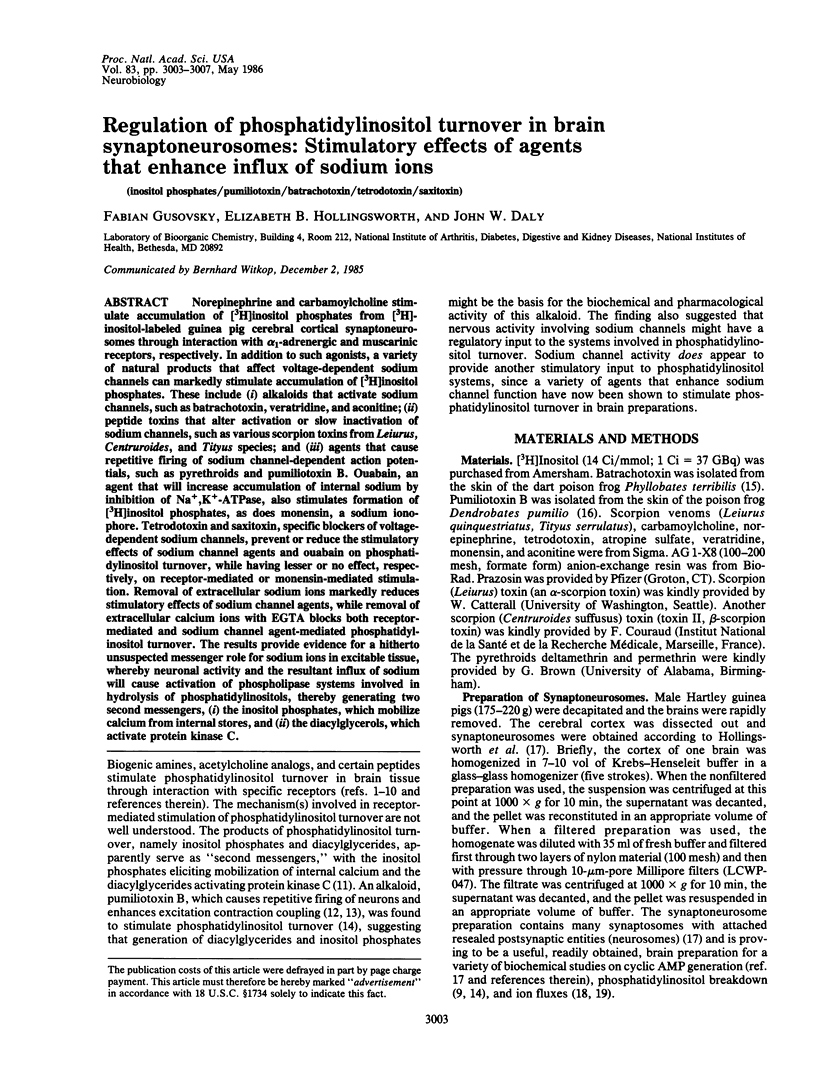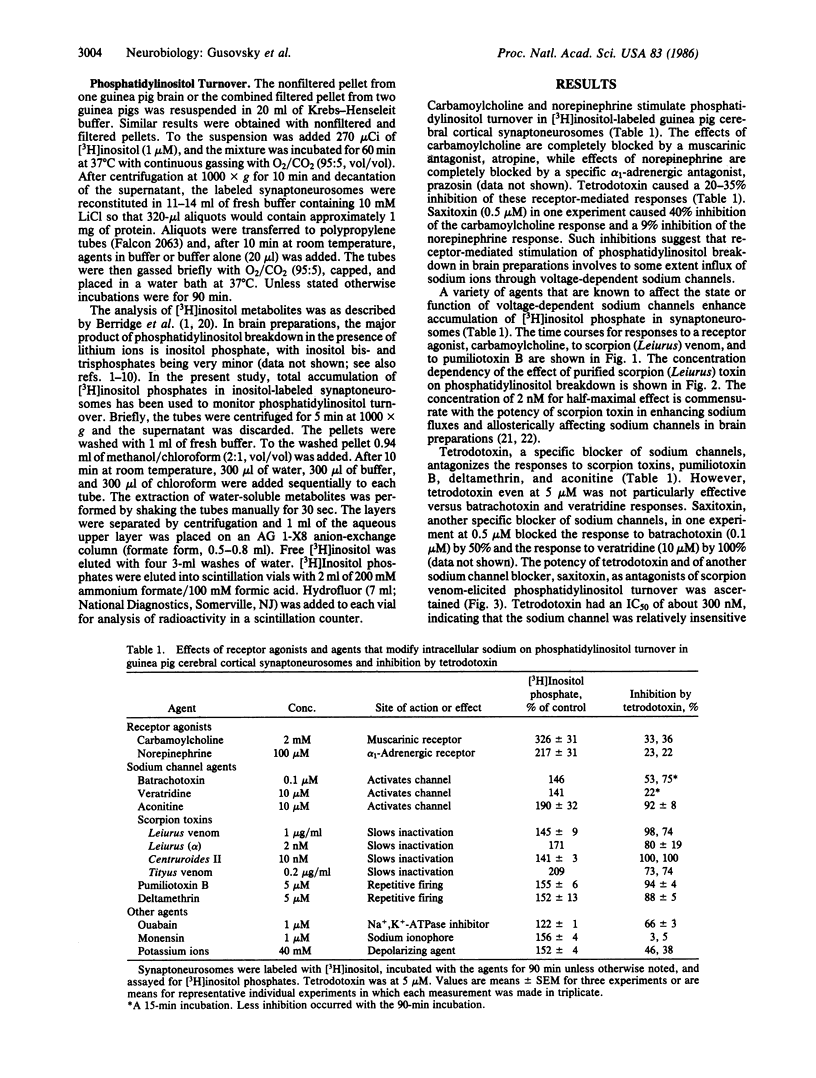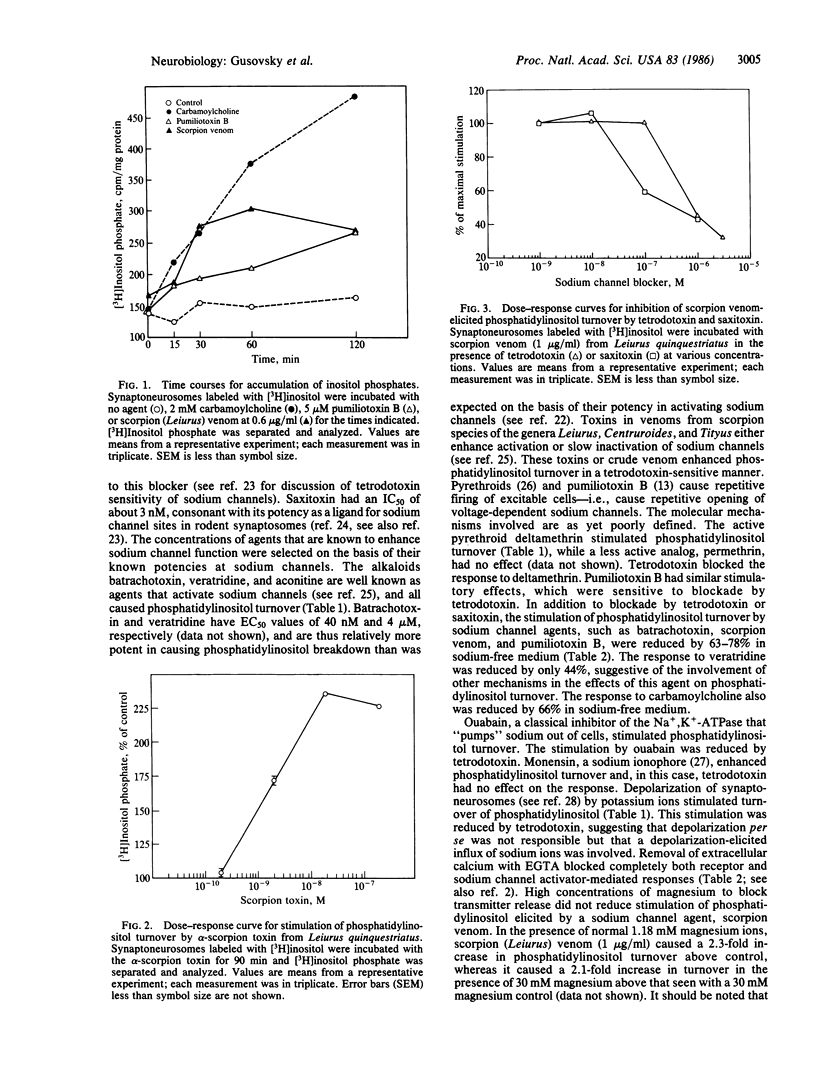Abstract
Norepinephrine and carbamoylcholine stimulate accumulation of [3H]inositol phosphates from [3H]inositol-labeled guinea pig cerebral cortical synaptoneurosomes through interaction with alpha 1-adrenergic and muscarinic receptors, respectively. In addition to such agonist, a variety of natural products that affect voltage-dependent sodium channels can markedly stimulate accumulation of [3H]inositol phosphates. These include alkaloids that activate sodium channels, such as batrachotoxin, veratridine, and aconitine; peptide toxins that alter activation or slow inactivation of sodium channels, such as various scorpion toxins from Leiurus, Centruroides, and Tityus species; and agents that cause repetitive firing of sodium channel-dependent action potentials, such as pyrethroids and pumiliotoxin B. Ouabain, and agent that will increase accumulation of internal sodium by inhibition of Na+, K+-ATPase, also stimulates formation of [3H]inositol phosphates, as does monensin, a sodium ionophore. Tetrodotoxin and saxitoxin, specific blockers of voltage-dependent sodium channels, prevent or reduce the stimulatory effects of sodium channel agents and ouabain on phosphatidylinositol turnover, while having lesser or no effect, respectively, on receptor-mediated or monensin-mediated stimulation. Removal of extracellular sodium ions markedly reduces stimulatory effects of sodium channel agents, while removal of extracellular calcium ions with EGTA blocks both receptor-mediated and sodium channel agent-mediated phosphatidylinositol turnover. The results provide evidence for a hitherto unsuspected messenger role for sodium ions in excitable tissue, whereby neuronal activity and the resultant influx of sodium will cause activation of phospholipase systems involved in hydrolysis of phosphatidylinositols, thereby generating two second messengers, the inositol phosphates, which mobilize calcium from internal stores, and the diacylglycerols, which activate protein kinase C.
Full text
PDF




Selected References
These references are in PubMed. This may not be the complete list of references from this article.
- Albuquerque E. X., Warnick J. E., Maleque M. A., Kauffman F. C., Tamburini R., Nimit Y., Daly J. W. The pharmacology of pumiliotoxin-B. I. Interaction with calcium sites in the sarcoplasmic reticulum of skeletal muscle. Mol Pharmacol. 1981 May;19(3):411–424. [PubMed] [Google Scholar]
- Baraban J. M., Snyder S. H., Alger B. E. Protein kinase C regulates ionic conductance in hippocampal pyramidal neurons: electrophysiological effects of phorbol esters. Proc Natl Acad Sci U S A. 1985 Apr;82(8):2538–2542. doi: 10.1073/pnas.82.8.2538. [DOI] [PMC free article] [PubMed] [Google Scholar]
- Berridge M. J., Dawson R. M., Downes C. P., Heslop J. P., Irvine R. F. Changes in the levels of inositol phosphates after agonist-dependent hydrolysis of membrane phosphoinositides. Biochem J. 1983 May 15;212(2):473–482. doi: 10.1042/bj2120473. [DOI] [PMC free article] [PubMed] [Google Scholar]
- Berridge M. J., Downes C. P., Hanley M. R. Lithium amplifies agonist-dependent phosphatidylinositol responses in brain and salivary glands. Biochem J. 1982 Sep 15;206(3):587–595. doi: 10.1042/bj2060587. [DOI] [PMC free article] [PubMed] [Google Scholar]
- Berridge M. J. Inositol trisphosphate and diacylglycerol as second messengers. Biochem J. 1984 Jun 1;220(2):345–360. doi: 10.1042/bj2200345. [DOI] [PMC free article] [PubMed] [Google Scholar]
- Blume A. J., Lichtshtein D., Boone G. Coupling of opiate receptors to adenylate cyclase: requirement for Na+ and GTP. Proc Natl Acad Sci U S A. 1979 Nov;76(11):5626–5630. doi: 10.1073/pnas.76.11.5626. [DOI] [PMC free article] [PubMed] [Google Scholar]
- Bone E. A., Michell R. H. Accumulation of inositol phosphates in sympathetic ganglia. Effects of depolarization and of amine and peptide neurotransmitters. Biochem J. 1985 Apr 1;227(1):263–269. doi: 10.1042/bj2270263. [DOI] [PMC free article] [PubMed] [Google Scholar]
- Brown E., Kendall D. A., Nahorski S. R. Inositol phospholipid hydrolysis in rat cerebral cortical slices: I. Receptor characterisation. J Neurochem. 1984 May;42(5):1379–1387. doi: 10.1111/j.1471-4159.1984.tb02798.x. [DOI] [PubMed] [Google Scholar]
- Catterall W. A., Morrow C. S., Daly J. W., Brown G. B. Binding of batrachotoxinin A 20-alpha-benzoate to a receptor site associated with sodium channels in synaptic nerve ending particles. J Biol Chem. 1981 Sep 10;256(17):8922–8927. [PubMed] [Google Scholar]
- Catterall W. A. The molecular basis of neuronal excitability. Science. 1984 Feb 17;223(4637):653–661. doi: 10.1126/science.6320365. [DOI] [PubMed] [Google Scholar]
- Cockcroft S., Gomperts B. D. Role of guanine nucleotide binding protein in the activation of polyphosphoinositide phosphodiesterase. Nature. 1985 Apr 11;314(6011):534–536. doi: 10.1038/314534a0. [DOI] [PubMed] [Google Scholar]
- Cohen-Armon M., Kloog Y., Henis Y. I., Sokolovsky M. Batrachotoxin changes the properties of the muscarinic receptor in rat brain and heart: possible interaction(s) between muscarinic receptors and sodium channels. Proc Natl Acad Sci U S A. 1985 May;82(10):3524–3527. doi: 10.1073/pnas.82.10.3524. [DOI] [PMC free article] [PubMed] [Google Scholar]
- Conn P. J., Sanders-Bush E. Serotonin-stimulated phosphoinositide turnover: mediation by the S2 binding site in rat cerebral cortex but not in subcortical regions. J Pharmacol Exp Ther. 1985 Jul;234(1):195–203. [PubMed] [Google Scholar]
- Costa M. R., Catterall W. A. Phosphorylation of the alpha subunit of the sodium channel by protein kinase C. Cell Mol Neurobiol. 1984 Sep;4(3):291–297. doi: 10.1007/BF00733592. [DOI] [PMC free article] [PubMed] [Google Scholar]
- Creveling C. R., McNeal E. T., McCulloh D. H., Daly J. W. Membrane potentials in cell-free preparations from guinea pig cerebral cortex: effect of depolarizing agents and cyclic nucleotides. J Neurochem. 1980 Oct;35(4):922–932. doi: 10.1111/j.1471-4159.1980.tb07091.x. [DOI] [PubMed] [Google Scholar]
- DeRiemer S. A., Strong J. A., Albert K. A., Greengard P., Kaczmarek L. K. Enhancement of calcium current in Aplysia neurones by phorbol ester and protein kinase C. Nature. 1985 Jan 24;313(6000):313–316. doi: 10.1038/313313a0. [DOI] [PubMed] [Google Scholar]
- Fisher S. K., Figueiredo J. C., Bartus R. T. Differential stimulation of inositol phospholipid turnover in brain by analogs of oxotremorine. J Neurochem. 1984 Oct;43(4):1171–1179. doi: 10.1111/j.1471-4159.1984.tb12858.x. [DOI] [PubMed] [Google Scholar]
- Goedert M., Pinnock R. D., Downes C. P., Mantyh P. W., Emson P. C. Neurotensin stimulates inositol phospholipid hydrolysis in rat brain slices. Brain Res. 1984 Dec 3;323(1):193–197. doi: 10.1016/0006-8993(84)90288-9. [DOI] [PubMed] [Google Scholar]
- Goswami S. K., Gould R. M. Effect of electrical stimulation on phosphoinositide metabolism in rat sciatic nerve in vivo. J Neurochem. 1985 Mar;44(3):941–946. doi: 10.1111/j.1471-4159.1985.tb12908.x. [DOI] [PubMed] [Google Scholar]
- Hazeki O., Ui M. Modification by islet-activating protein of receptor-mediated regulation of cyclic AMP accumulation in isolated rat heart cells. J Biol Chem. 1981 Mar 25;256(6):2856–2862. [PubMed] [Google Scholar]
- Hollingsworth E. B., Daly J. W. Accumulation of inositol phosphates and cyclic AMP in guinea-pig cerebral cortical preparations. Effects of norepinephrine, histamine, carbamylcholine and 2-chloroadenosine. Biochim Biophys Acta. 1985 Nov 20;847(2):207–216. doi: 10.1016/0167-4889(85)90022-9. [DOI] [PubMed] [Google Scholar]
- Hollingsworth E. B., McNeal E. T., Burton J. L., Williams R. J., Daly J. W., Creveling C. R. Biochemical characterization of a filtered synaptoneurosome preparation from guinea pig cerebral cortex: cyclic adenosine 3':5'-monophosphate-generating systems, receptors, and enzymes. J Neurosci. 1985 Aug;5(8):2240–2253. doi: 10.1523/JNEUROSCI.05-08-02240.1985. [DOI] [PMC free article] [PubMed] [Google Scholar]
- Jacobson M. D., Wusteman M., Downes C. P. Muscarinic receptors and hydrolysis of inositol phospholipids in rat cerebral cortex and parotid gland. J Neurochem. 1985 Feb;44(2):465–472. doi: 10.1111/j.1471-4159.1985.tb05437.x. [DOI] [PubMed] [Google Scholar]
- Jakobs K. H., Aktories K., Shultz G. Acceleration of the adipocyte adenylate cyclase turn-off reaction by inhibitory hormonal factors. Proc Natl Acad Sci U S A. 1982 Mar;79(5):1373–1377. doi: 10.1073/pnas.79.5.1373. [DOI] [PMC free article] [PubMed] [Google Scholar]
- Johnson R. D., Minneman K. P. Alpha 1-adrenergic receptors and stimulation of [3H]inositol metabolism in rat brain: regional distribution and parallel inactivation. Brain Res. 1985 Aug 19;341(1):7–15. doi: 10.1016/0006-8993(85)91466-0. [DOI] [PubMed] [Google Scholar]
- Kendall D. A., Nahorski S. R. 5-Hydroxytryptamine-stimulated inositol phospholipid hydrolysis in rat cerebral cortex slices: pharmacological characterization and effects of antidepressants. J Pharmacol Exp Ther. 1985 May;233(2):473–479. [PubMed] [Google Scholar]
- Kendall D. A., Nahorski S. R. Inositol phospholipid hydrolysis in rat cerebral cortical slices: II. Calcium requirement. J Neurochem. 1984 May;42(5):1388–1394. doi: 10.1111/j.1471-4159.1984.tb02799.x. [DOI] [PubMed] [Google Scholar]
- Lichtshtein D., Dunlop K., Kaback H. R., Blume A. J. Mechanism of monensin-induced hyperpolarization of neuroblastoma-glioma hybrid NG108-15. Proc Natl Acad Sci U S A. 1979 Jun;76(6):2580–2584. doi: 10.1073/pnas.76.6.2580. [DOI] [PMC free article] [PubMed] [Google Scholar]
- Nakamura T., Ui M. Simultaneous inhibitions of inositol phospholipid breakdown, arachidonic acid release, and histamine secretion in mast cells by islet-activating protein, pertussis toxin. A possible involvement of the toxin-specific substrate in the Ca2+-mobilizing receptor-mediated biosignaling system. J Biol Chem. 1985 Mar 25;260(6):3584–3593. [PubMed] [Google Scholar]
- Narahashi T. Modification of nerve membrane sodium channels by the insecticide pyrethroids. Comp Biochem Physiol C. 1982;72(2):411–414. doi: 10.1016/0306-4492(82)90112-5. [DOI] [PubMed] [Google Scholar]
- Pauron D., Barhanin J., Lazdunski M. The voltage-dependent Na+ channel of insect nervous system identified by receptor sites for tetrodotoxin, and scorpion and sea anemone toxins. Biochem Biophys Res Commun. 1985 Sep 30;131(3):1226–1233. doi: 10.1016/0006-291x(85)90222-0. [DOI] [PubMed] [Google Scholar]
- Pressman B. C. Biological applications of ionophores. Annu Rev Biochem. 1976;45:501–530. doi: 10.1146/annurev.bi.45.070176.002441. [DOI] [PubMed] [Google Scholar]
- Ray R., Morrow C. S., Catterall W. A. Binding of scorpion toxin to receptor sites associated with voltage-sensitive sodium channels in synaptic nerve ending particles. J Biol Chem. 1978 Oct 25;253(20):7307–7313. [PubMed] [Google Scholar]
- Schwartz R. D., Jackson J. A., Weigert D., Skolnick P., Paul S. M. Characterization of barbiturate-stimulated chloride efflux from rat brain synaptoneurosomes. J Neurosci. 1985 Nov;5(11):2963–2970. doi: 10.1523/JNEUROSCI.05-11-02963.1985. [DOI] [PMC free article] [PubMed] [Google Scholar]
- Schwartz R. D., Skolnick P., Hollingsworth E. B., Paul S. M. Barbiturate and picrotoxin-sensitive chloride efflux in rat cerebral cortical synaptoneurosomes. FEBS Lett. 1984 Sep 17;175(1):193–196. doi: 10.1016/0014-5793(84)80597-9. [DOI] [PubMed] [Google Scholar]
- Siess W., Lapetina E. G. Properties and distribution of phosphatidylinositol-specific phospholipase C in human and horse platelets. Biochim Biophys Acta. 1983 Jul 12;752(2):329–338. doi: 10.1016/0005-2760(83)90131-5. [DOI] [PubMed] [Google Scholar]
- Vicentini L. M., Meldolesi J. alpha Latrotoxin of black widow spider venom binds to a specific receptor coupled to phosphoinositide breakdown in PC12 cells. Biochem Biophys Res Commun. 1984 Jun 15;121(2):538–544. doi: 10.1016/0006-291x(84)90215-8. [DOI] [PubMed] [Google Scholar]
- Weigele J. B., Barchi R. L. Analysis of saxitoxin binding in isolated rat synaptosomes using a rapid filtration assay. FEBS Lett. 1978 Jul 15;91(2):310–314. doi: 10.1016/0014-5793(78)81199-5. [DOI] [PubMed] [Google Scholar]


